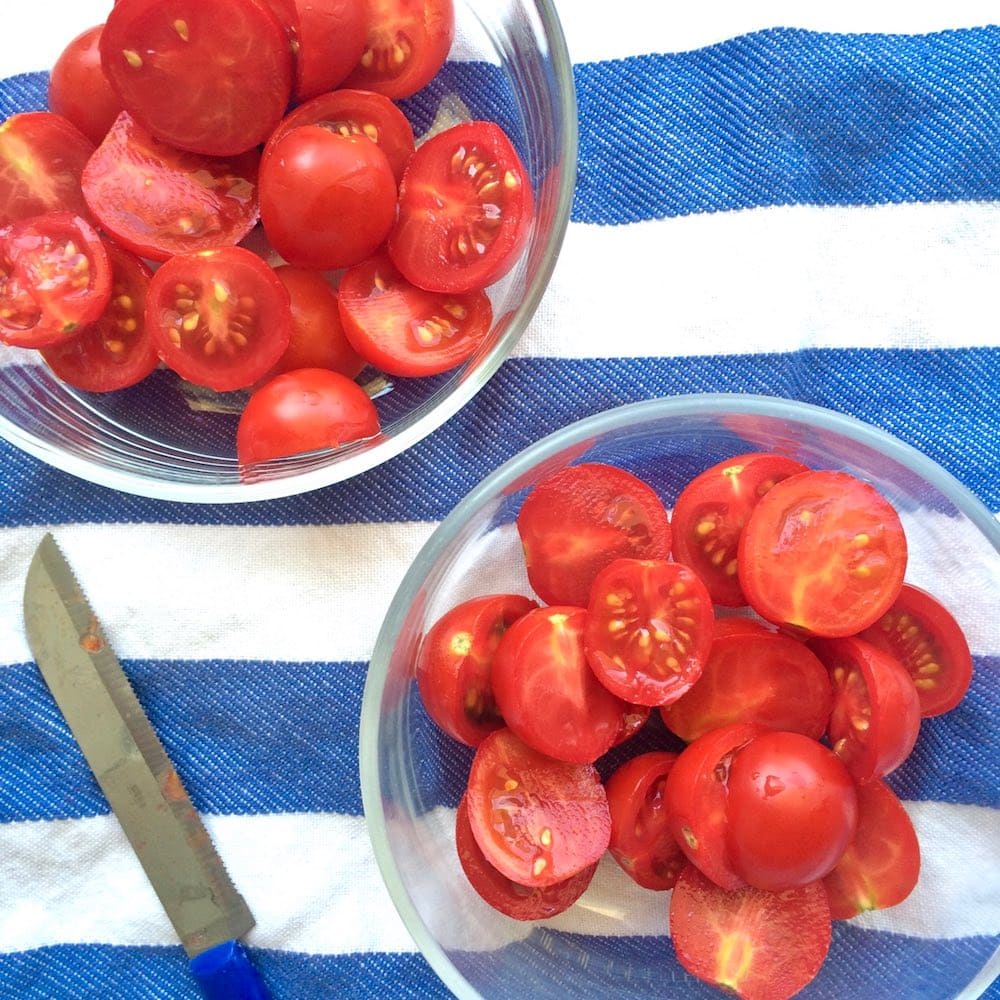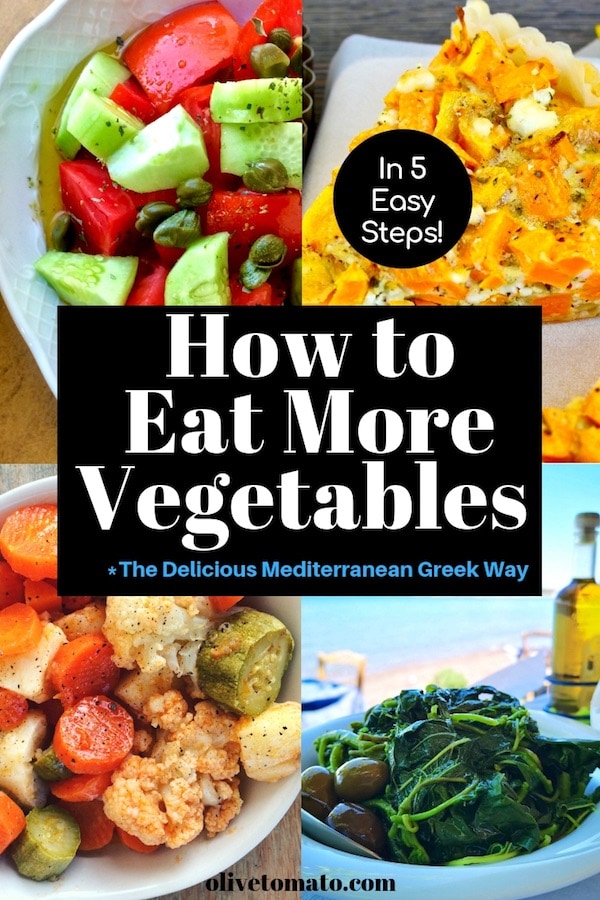5 Ways to Eat More Vegetables The Greek Way
A recent study published in the British Medical Journal showed that individuals who consumed 7 or more servings of vegetables a day had a reduced risk of dying from cancer and heart disease.
While we know that the traditional Greek diet was mostly vegetarian due to the religious fasts, but also to economic reasons, today Greeks have moved away from their traditional diet eating a more westernized diet, but surprisingly still consume plenty of vegetables. In fact, according to a 2010 OECD report, Greece has the highest consumption of vegetables per capita in Europe based on supply and production, however it is mostly older Greeks that still eat more vegetables. Here is how we do it:
1. Greeks eat cooked vegetables as a main course
This is probably the most important thing you can do to increase your intake of vegetables drastically without really noticing. As I’ve mentioned before I always found it ineffective the way western diets try to increase vegetable intake by either trying to persuade us to eat boiled or steamed vegetables with some butter or loaded with melted cheese. That is not the way to go, for the simple reason that you need tons of butter and cheese to make these boring vegetables tasty, which defeats the purpose. Instead you can try cooking vegetables such as green beans, peas, eggplant, zucchini, okra, cauliflower with olive oil, onion, tomatoes and herbs in a pot or in the oven. These dishes are often called lathera from the Greek word for oil “lathi” and we eat a plate of this vegetable casserole along with some feta cheese and a slice of bread. When we make vegetables this way, an average adult serving usually corresponds to ½ pound of vegetables, that is about 4 servings of vegetables in one sitting. Check here, here, and here for recipes for these vegetable casseroles or roasted vegetables.
2. Greeks eat seasonal salads with every meal
It’s not enough that we eat vegetables as a main course, a seasonal salad was always in the middle of the table regardless of what the main course is. However, it is important to note that the salads are made from seasonal vegetables. So in the summer months you’ll see the famous Greek salad or more often what we call aggourodomata (which means cucumber-tomato all in one word) along with some olive oil and oregano. In the winter and spring months the salads at the table are cabbage and carrot with a bit of olive oil and vinegar or lemon or a “prasini”-green salad as we call it made with romaine lettuce and spring onion. While in restaurants you will find Greek salads with tomato in the winter, they are generally tasteless but consumers often ask for them perhaps not understanding that tomatoes are not in season in the winter and don’t taste all that great.
3. Greeks eat weeds and other wild greens
Yes these weeds are also known as horta. You have probably heard stories or witnessed this if you are a Greek-something: grandmothers picking dandelion weeds from the backyard. This was common in our household too, although my mom did this and of course our neighbors found this strange. But this dietary habit is the secret to the famous Greek-Mediterranean Diet. While in the U.S. they recently discovered the wonder of leafy greens, in Greece these greens have been the basis of the diet because it was accessible to all and free, anybody can pick them. They have very few calories, rich in antioxidants and are filling. We lightly boil them and eat them with olive oil, lemon and cheese. In Crete they have over 150 varieties of greens and edible plants. Above in the photo, is a “salad” of lightly boiled Cretan greens stamnagathi and the white roots of the plant askolibri along with olive oil, a barley rusk and some fresh cheese. You can eat several types of greens this way, just lightly boil, add some good olive oil, a bit of lemon and some cheese.
4. Greeks add tomato to everything
Tomato is a vegetable, and tomato sauce or canned chopped tomatoes also count as a vegetable, and in Greek recipes tomato is added everywhere, even in meat dishes. In the vegetable casserole mentioned above, tomato is added to make the sauce so you are getting another serving of vegetables there. This is the case with meat as well. We make our chicken, beef, lamb and many other meals with plenty of tomatoes. Just one more way to get vegetables plus tomato is rich in lycopene an antioxidant that may protect from certain types of cancer. Go here and here for meat and fish recipes made with tomato.
5. Greeks eat a lot of vegetable pies
What are vegetable pies you say? Spanakopita is a famous Greek vegetable pie, we call them pites, not like pita bread, pita also means something wrapped in phyllo. Phyllo can be thin like the one you often find frozen in super markets, but also thick, homemade phyllo made with olive oil. Basically, pites would be made with a variety of vegetables and greens such as spinach, leeks, greens, zucchini, peppers, mushrooms, artichokes and the list goes on and on. Basically anything in season. These pies were either vegan especially during the fasting periods so they were made with vegetables, herbs and olive oil. Or during non-fasting days cheese and egg may be added. This is the original Greek fast food, because these were easy to carry with you and did not require refrigeration. Today you find pites everywhere in Greece. They can easily make a filling lunch plus it is another easy way to eat vegetables. For pita recipes go here, here and here.



I would love to live somewhere that would make wild greens available to me. Sometimes once in a great while dandelion greens or chichory are available in the stores. I’ve lived for just a little while in places where you could just pick them, and even the act of going and picking something that comes directly from the earth without cultivation is so pleasant and a reminder that nature will provide us with such nutritious and tasty delights. Many of the plants can also be dried and used for teas. Nettles, for example, can be used this way and this also neutralizes their sting. For that matter, cooking nettles will render them harmless as well.
Thanks for sharing Madeline. There are seeds available for some greens such as chicory and endive.
Thanks for sharing, love the horta with the eggs idea!
We ate agria horta boiled with olive oil and vinegar. The left overs were a morning treat with scrambled eggs or without. Fried in the pan wit a little olive oil and some chopped garlic. And homemade bread from grandma. Heaven on Earth. Miss my mom and grandma. Now they are cooking in Heaven.
Hi Elena – I love your site, and have made many of your recipes.
Just a word of advice – instead of saying “Go here and here”, if you substitute the recipe names for the word “here”, it would be more useful for your readers, as we can choose which ones to look at.
Hi Elena,
Love your site and all the information you provide, but being a pedantic scientist (and at the risk of sounding like a smart-ass) I have to point out that tomatoes are not vegetables – they are fruit. Just don’t put them in your fruit salad though 😉
Best,
D
Thanks David! Glad you like the site. Yes, I am aware, but as tomato is used as a vegetable in cooking, we refer to it as a vegetable, to not cause too much confusion.
In the photo there’s χόρτα, pomegranate seeds – and what are those long, thin strips?
Hi Steve,
That is the white roots of the plant askolibri, you see it everywhere in Crete. I also mention them in the article.
Great information! I started eating many more vegetables last year after a diagnosis of gallstones, which were causing a lot of pain at times. Since I changed my diet, I have not had any attacks. Plus I have lost about 50 pounds without even dieting. Of course my BP has also dropped about 20 points from the weight loss.
Your article inspires me to incorporate even more vegetables into my diet. Would love to see an article about what the traditional Greek breakfasts are like, and more about traditional herbs and teas.
Thanks Annie for sharing and congratulations! Here is a link about herbal teas: https://www.olivetomato.com/live-longer-with-the-greek-lifestyle-eat-plants-and-drink-wine/
And here is one about the Greek breakfast: https://www.olivetomato.com/food-in-greece/when-greeks-eat/
Though I cook and eat escarole salad as horta as much as I can, I really miss my grandmother’s dandelions — tiganista!
Nothing like Yiayia’s cooking!
Great article. Can u recommend how to include more fish into these fabulous recipes if possible? Cheers
Thanks Charlie. I have some fish recipes on the site but will be adding more.
Greetings from a mediterranean diet enthusiast from Poland!:)I love your website, this article was very interesting. We’ve got lots of dandelion weeds here in Poland – this year I’m planning to gather some leaves and prepare horta for my family:)
Hello Zuzanna. Thank you! Enjoy your horta!